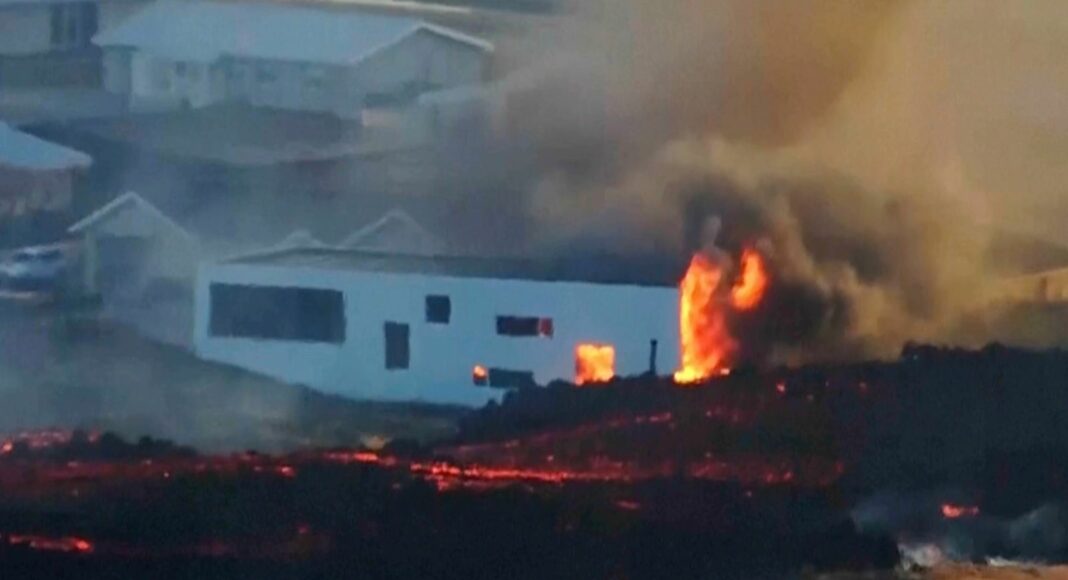A volcano has erupted in southwestern Iceland, sending lava flowing towards a fishing village that had to be evacuated overnight.
The semi-molten rock has consumed at least two buildings on the outskirts of Grindavik – a town which also had to be evacuated in November before a massive eruption from the same peninsula.
In the weeks since, defensive walls were constructed around the volcano in the hope of directing magma away from the community of around 3,800 people.
But the barriers of earth and rock that were built north of Grindavik were been breached and lava has been moving towards the town, the Icelandic Meteorological Office (IMO) said.
Footage showed that one structure, thought to be a home, caught fire on Sunday afternoon after lava crept towards it, while another building nearby was also hit.
0:41
Whole town at ‘the mercy of the magma’
Image:
Fire in Grindavik
It came after Iceland’s President Gudni Johannesson wrote in a post on the X social media platform: “No lives are in danger, although infrastructure may be under threat.”
He added there had been no interruptions to flights.
Image:
A line of lava and fire on the outskirts of Grindavik
Image:
A volcano spews lava and smoke as it erupts in the Reykjanes peninsula
The nearby geothermal spa Blue Lagoon closed on Sunday due to “an increase in seismic activity detected in the area,” the popular tourist attraction said on its website.
The eruption comes after a series of earthquakes in the region.
“Lava is flowing a few hundred metres north of the town – this is 400 to 500 metres,” Kristin Jonsdottir, from the IMO, earlier told national broadcaster RUV.
“Lava flows towards Grindavik.”
The IMO said in a separate statement: “According to the first images from the coast guard’s surveillance flight, a crack has opened on both sides of the defences that have begun to be built north of Grindavík.”
Sunday’s eruption is the fifth to take place in the Reykjanes peninsula since 2021.
Image:
A view of Sunday’s volcano eruption
A spectacular eruption took place in December, with lava emerging from a two-mile-long crack in the Earth’s surface after weeks of intense earthquake activity in the region.
Grindavik was ultimately spared as the lava flowed in a different direction from the town.
People had been evacuated from their homes in November and had to stay away from the Grindavik for six weeks.
Grindavik residents were allowed to return on 22 December.
On Saturday, rescuers were searching for a man who fell into a crack in the ground that opened up after last month’s eruption.
The man had been working to fill crevasses formed by earthquakes and volcanic activity in Grindavik, according to local media.
Hundreds of people have been looking for him since Wednesday but had to stop shortly before midnight on Thursday due to a rockfall.
It’s a dynamic situation and scientists can’t predict what comes next
This is Iceland’s worst eruption in more than 50 years.
In 1973 the island of Heimaey was evacuated after lava erupted on the edge of the settlement.
And now it’s happening again to the thriving fishing town of Grindavik.
People have been evacuated so there’s no risk to life. But some properties have already been consumed and the community that people had built over generations is at risk.
This eruption is along the same fault through the Reykjanes Peninsula that opened up before Christmas in a spectacular wall of fire.
That eruption ended almost as abruptly as it started. But scientists had warned the volcano wasn’t done.
The ground had risen by several centimetres in recent days, pushed up by magma rising from beneath.
An earthquake swarm in the early hours of Sunday morning signalled it was about to breach the surface.
At first it opened a one kilometre gash, closer to Grindavik than last time. Then a smaller fissure opened even closer to people’s homes.
The ground in the area is shifting as the magma moves. New cracks have opened up in the town and those that already existed from previous seismic activity have widened.
It’s a dynamic situation and scientists can’t predict where or when the magma will erupt next.
Iceland, which sits above a volcanic hot spot in the North Atlantic, averages an eruption every four to five years.
The most disruptive in recent times was the 2010 eruption of the Eyjafjallajokull volcano, which spewed huge clouds of ash into the atmosphere and led to widespread airspace closures over Europe.
Unlike Eyjafjallajokull, the Reykjanes volcano systems are not trapped under glaciers and are therefore not expected to cause similar ash clouds.




